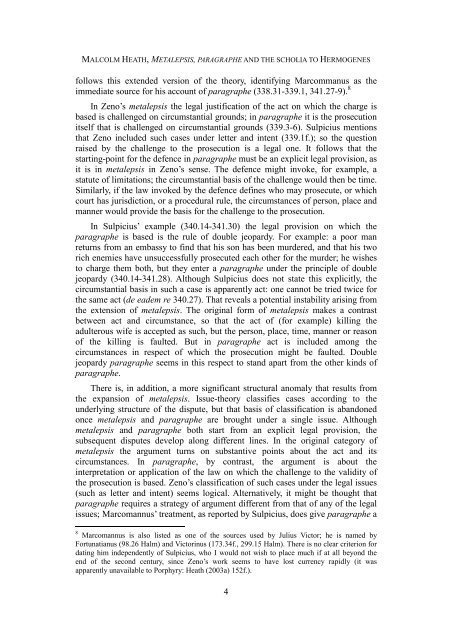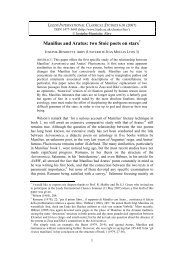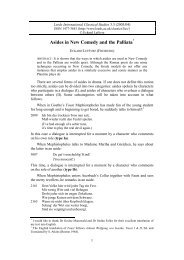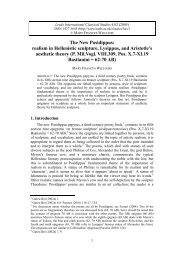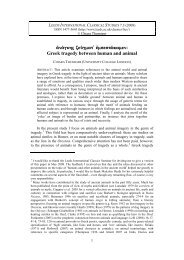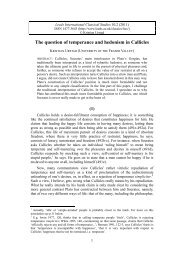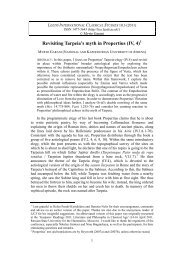Metalepsis, paragraphe and the scholia to Hermogenes - Leeds ...
Metalepsis, paragraphe and the scholia to Hermogenes - Leeds ...
Metalepsis, paragraphe and the scholia to Hermogenes - Leeds ...
Create successful ePaper yourself
Turn your PDF publications into a flip-book with our unique Google optimized e-Paper software.
MALCOLM HEATH, METALEPSIS, PARAGRAPHE AND THE SCHOLIA TO HERMOGENES<br />
follows this extended version of <strong>the</strong> <strong>the</strong>ory, identifying Marcommanus as <strong>the</strong><br />
immediate source for his account of <strong>paragraphe</strong> (338.31-339.1, 341.27-9). 8<br />
In Zeno’s metalepsis <strong>the</strong> legal justification of <strong>the</strong> act on which <strong>the</strong> charge is<br />
based is challenged on circumstantial grounds; in <strong>paragraphe</strong> it is <strong>the</strong> prosecution<br />
itself that is challenged on circumstantial grounds (339.3-6). Sulpicius mentions<br />
that Zeno included such cases under letter <strong>and</strong> intent (339.1f.); so <strong>the</strong> question<br />
raised by <strong>the</strong> challenge <strong>to</strong> <strong>the</strong> prosecution is a legal one. It follows that <strong>the</strong><br />
starting-point for <strong>the</strong> defence in <strong>paragraphe</strong> must be an explicit legal provision, as<br />
it is in metalepsis in Zeno’s sense. The defence might invoke, for example, a<br />
statute of limitations; <strong>the</strong> circumstantial basis of <strong>the</strong> challenge would <strong>the</strong>n be time.<br />
Similarly, if <strong>the</strong> law invoked by <strong>the</strong> defence defines who may prosecute, or which<br />
court has jurisdiction, or a procedural rule, <strong>the</strong> circumstances of person, place <strong>and</strong><br />
manner would provide <strong>the</strong> basis for <strong>the</strong> challenge <strong>to</strong> <strong>the</strong> prosecution.<br />
In Sulpicius’ example (340.14-341.30) <strong>the</strong> legal provision on which <strong>the</strong><br />
<strong>paragraphe</strong> is based is <strong>the</strong> rule of double jeopardy. For example: a poor man<br />
returns from an embassy <strong>to</strong> find that his son has been murdered, <strong>and</strong> that his two<br />
rich enemies have unsuccessfully prosecuted each o<strong>the</strong>r for <strong>the</strong> murder; he wishes<br />
<strong>to</strong> charge <strong>the</strong>m both, but <strong>the</strong>y enter a <strong>paragraphe</strong> under <strong>the</strong> principle of double<br />
jeopardy (340.14-341.28). Although Sulpicius does not state this explicitly, <strong>the</strong><br />
circumstantial basis in such a case is apparently act: one cannot be tried twice for<br />
<strong>the</strong> same act (de eadem re 340.27). That reveals a potential instability arising from<br />
<strong>the</strong> extension of metalepsis. The original form of metalepsis makes a contrast<br />
between act <strong>and</strong> circumstance, so that <strong>the</strong> act of (for example) killing <strong>the</strong><br />
adulterous wife is accepted as such, but <strong>the</strong> person, place, time, manner or reason<br />
of <strong>the</strong> killing is faulted. But in <strong>paragraphe</strong> act is included among <strong>the</strong><br />
circumstances in respect of which <strong>the</strong> prosecution might be faulted. Double<br />
jeopardy <strong>paragraphe</strong> seems in this respect <strong>to</strong> st<strong>and</strong> apart from <strong>the</strong> o<strong>the</strong>r kinds of<br />
<strong>paragraphe</strong>.<br />
There is, in addition, a more significant structural anomaly that results from<br />
<strong>the</strong> expansion of metalepsis. Issue-<strong>the</strong>ory classifies cases according <strong>to</strong> <strong>the</strong><br />
underlying structure of <strong>the</strong> dispute, but that basis of classification is ab<strong>and</strong>oned<br />
once metalepsis <strong>and</strong> <strong>paragraphe</strong> are brought under a single issue. Although<br />
metalepsis <strong>and</strong> <strong>paragraphe</strong> both start from an explicit legal provision, <strong>the</strong><br />
subsequent disputes develop along different lines. In <strong>the</strong> original category of<br />
metalepsis <strong>the</strong> argument turns on substantive points about <strong>the</strong> act <strong>and</strong> its<br />
circumstances. In <strong>paragraphe</strong>, by contrast, <strong>the</strong> argument is about <strong>the</strong><br />
interpretation or application of <strong>the</strong> law on which <strong>the</strong> challenge <strong>to</strong> <strong>the</strong> validity of<br />
<strong>the</strong> prosecution is based. Zeno’s classification of such cases under <strong>the</strong> legal issues<br />
(such as letter <strong>and</strong> intent) seems logical. Alternatively, it might be thought that<br />
<strong>paragraphe</strong> requires a strategy of argument different from that of any of <strong>the</strong> legal<br />
issues; Marcomannus’ treatment, as reported by Sulpicius, does give <strong>paragraphe</strong> a<br />
8 Marcomannus is also listed as one of <strong>the</strong> sources used by Julius Vic<strong>to</strong>r; he is named by<br />
Fortunatianus (98.26 Halm) <strong>and</strong> Vic<strong>to</strong>rinus (173.34f., 299.15 Halm). There is no clear criterion for<br />
dating him independently of Sulpicius, who I would not wish <strong>to</strong> place much if at all beyond <strong>the</strong><br />
end of <strong>the</strong> second century, since Zeno’s work seems <strong>to</strong> have lost currency rapidly (it was<br />
apparently unavailable <strong>to</strong> Porphyry: Heath (2003a) 152f.).<br />
4


